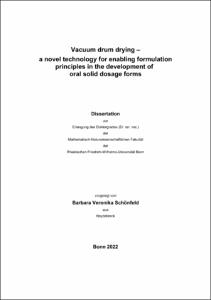Vacuum drum dryinga novel technology for enabling formulation principles in the development of oral solid dosage forms

Vacuum drum drying
a novel technology for enabling formulation principles in the development of oral solid dosage forms

| dc.contributor.advisor | Wagner, Karl Gerhard | |
| dc.contributor.author | Schönfeld, Barbara Veronika | |
| dc.date.accessioned | 2022-11-21T17:02:57Z | |
| dc.date.available | 2022-11-21T17:02:57Z | |
| dc.date.issued | 21.11.2022 | |
| dc.identifier.uri | https://hdl.handle.net/20.500.11811/10455 | |
| dc.description.abstract | The present work demonstrates the applicability of vacuum drum drying (VDD) as novel technology in the development of solid, oral dosage forms for two enabling formulation principles: a) manufacture of amorphous solid dispersions (ASD) and b) processing crystalline drug nanosuspensions into solidified nanocrystals.
For the ASD approach, vacuum drum drying as solvent-evaporation based technology was assessed in comparison with conventional technologies, namely hot melt extrusion and spray drying focusing on a model formulation consisting of ritonavir in a copovidone/sorbitan monolaurate matrix. The ASD intermediates showed similar quality attributes such as drug substance related crystallinity, whereas differences in particle morphology and related powder properties were observed leading to differences in compression behavior and related tablet characterization. However, all ASD intermediates (powder in capsule or tablets) indicated similar disintegration/dissolution. The addition of outer phase excipients to the ASD intermediates levelled the differences observed while not affecting the dissolution behavior. Furthermore, the compression modulus of polymeric excipients was evaluated compared to non-polymeric ones, and its consequences on commonly used Heckel analysis. It was found that the particle density (via helium pycnometer) was already exceeded at low compaction pressures (< 200 MPa) for polymeric excipients (Kollidon®VA64, Soluplus®, AQOAT®AS-MMP, Starch1500®, Avicel®PH101) as well as for an ASD example consisting of ritonavir, whereas either never reached for brittle fillers such as DI CAFOS®A60 and tricalcium citrate or exceeded at compaction pressures above 350 MPa in the case of FlowLac®100, Pearlitol®100SD. The threshold for exceeding particle density was in accordance with the start of linear increase in elastic recovery in-die and thus, with predominantly elastic deformation. The threshold provides guidance for the selection of suitable excipients in the formulation development to mitigate the risk for tablet defects related to stored elastic energy. Last, the processing of drug nanosuspensions to solidified nanocrystals via vacuum drum drying was investigated for a ritonavir based nanosuspension prepared by wet-ball milling. Drying protectants (mannitol, lactose, trehalose) added to the ritonavir nanosuspension substantially impacted processibility via VDD, resulting remaining nanoparticulate redispersibility and crystallinity in dependence of the drum temperature. Moreover, a formulation specific drum temperature Tcrit was identified as critical for remaining ritonavir nanoparticulate redispersibility/crystallinity, which might be linked to the glass transition temperature of the pure drying protectant. | en |
| dc.language.iso | eng | |
| dc.rights | Namensnennung - Nicht kommerziell - Keine Bearbeitungen 4.0 International | |
| dc.rights.uri | http://creativecommons.org/licenses/by-nc-nd/4.0/ | |
| dc.subject | vacuum drum drying | |
| dc.subject | spray drying | |
| dc.subject | hot-melt extrusion | |
| dc.subject | amorphous solid dispersion | |
| dc.subject | nanocrystals | |
| dc.subject | drying protectants | |
| dc.subject | compression modulus | |
| dc.subject | elastic recovery | |
| dc.subject | tabletability | |
| dc.subject | ritonavir | |
| dc.subject.ddc | 500 Naturwissenschaften | |
| dc.title | Vacuum drum drying | |
| dc.title.alternative | a novel technology for enabling formulation principles in the development of oral solid dosage forms | |
| dc.type | Dissertation oder Habilitation | |
| dc.publisher.name | Universitäts- und Landesbibliothek Bonn | |
| dc.publisher.location | Bonn | |
| dc.rights.accessRights | openAccess | |
| dc.identifier.urn | https://nbn-resolving.org/urn:nbn:de:hbz:5-68713 | |
| dc.relation.doi | https://doi.org/10.1016/j.ijpharm.2021.120233 | |
| dc.relation.doi | https://doi.org/10.1016/j.ijpx.2021.100102 | |
| dc.relation.doi | https://doi.org/10.3390/pharmaceutics14050913 | |
| dc.relation.doi | https://doi.org/10.1208/s12249-022-02283-z | |
| ulbbn.pubtype | Erstveröffentlichung | |
| ulbbnediss.affiliation.name | Rheinische Friedrich-Wilhelms-Universität Bonn | |
| ulbbnediss.affiliation.location | Bonn | |
| ulbbnediss.thesis.level | Dissertation | |
| ulbbnediss.dissID | 6871 | |
| ulbbnediss.date.accepted | 24.10.2022 | |
| ulbbnediss.institute | Mathematisch-Naturwissenschaftliche Fakultät : Fachgruppe Pharmazie / Pharmazeutisches Institut | |
| ulbbnediss.fakultaet | Mathematisch-Naturwissenschaftliche Fakultät | |
| dc.contributor.coReferee | Lamprecht, Alf | |
| ulbbnediss.contributor.orcid | https://orcid.org/0000-0003-3057-2707 | |
| ulbbnediss.contributor.gnd | 1280829516 |
Dateien zu dieser Ressource
Das Dokument erscheint in:
-
E-Dissertationen (4337)




